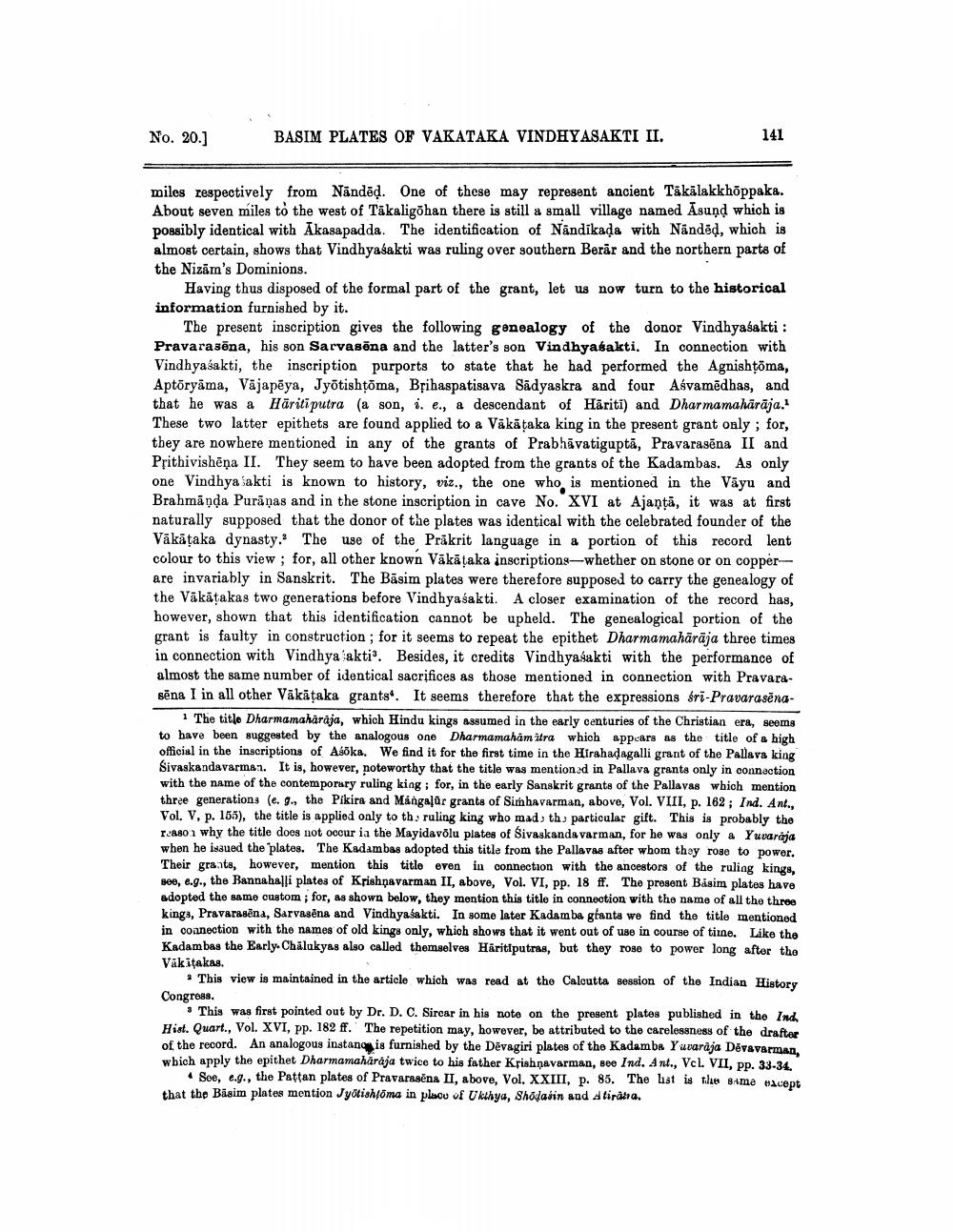________________
No. 20.]
BASIM PLATES OF VAKATAKA VINDHYASAKTI II.
141
miles respectively from Nändēd. One of these may represent ancient Täkälakkhõppaka. About seven miles to the west of Takaligohan there is still a small village named Asund which is possibly identical with Akasapadda. The identification of Nândikada with Nanded, which is almost certain, shows that Vindhyasakti was ruling over southern Berar and the northern parts of the Nizam's Dominions.
Having thus disposed of the formal part of the grant, let us now turn to the historical information furnished by it.
The present inscription gives the following genealogy of the donor Vindhyasakti : Pravarasēna, his son Sarvasēna and the latter's son Vindhyasakti. In connection with Vindhyasakti, the inscription purports to state that he had performed the Agnishtöma, Aptöryāma, Vajapěya, Jyotishtöma, Bțihaspatisava Sädyaskra and four Asvamëdhas, and that he was a Häriti putra (a son, i. e., a descendant of Hariti) and Dhar mamahārāja. These two latter epithets are found applied to a Väkätaka king in the present grant only; for, they are nowhere mentioned in any of the grants of Prabhāvatiguptă, Pravarasēna II and Prithivishēņa II. They seem to have been adopted from the grants of the Kadambas. As only one Vindhyasakti is known to history, viz., the one who is mentioned in the Väyu and Brahmānda Purāņas and in the stone inscription in cave No. XVI at Ajantā, it was at first naturally supposed that the donor of the plates was identical with the celebrated founder of the Vākāțaka dynasty. The use of the Prākrit language in a portion of this record lent colour to this view ; for, all other known Vākātaka inscriptions-whether on stone or on copperare invariably in Sanskrit. The Bāsim plates were therefore supposed to carry the genealogy of the Väkāțakas two generations before Vindhyasakti. A closer examination of the record has, however, shown that this identification cannot be upheld. The genealogical portion of the grant is faulty in construction; for it seems to repeat the epithet Dharmamahärāja three times in connection with Vindhya akti'. Besides, it credits Vindhyasakti with the performance of almost the same number of identical sacrifices as those mentioned in connection with Pravarasēna I in all other Väkätaka grants. It seems therefore that the expressions sri-Pravarasēna
The title Dharmamaharaja, which Hindu kings assumed in the early centuries of the Christian era, seems to have been suggested by the analogous one Dharmamahamitra which appears as the title of a high official in the inscriptions of Asöka. We find it for the first time in the Hirahadagalli grant of the Pallava king Sivaskandavarman. It is, however, noteworthy that the title was mentioned in Pallava granta only in connection with the name of the contemporary ruling king : for, in the early Sanskrit grants of the Pallavas which mention three generations (e. 9., the Pikira and Mangalûr grants of Simbavarman, above, Vol. VIII, p. 162; Ind. Ant. Vol. V. p. 155), the title is applied only to th, ruling king who mad, th, particular gift. This is probably the T-880 why the title does not occur ia the Mayidavõlu plates of Sivaskanda varman, for he was only a Yuvarija when he isaued the plates. The Kadambas adopted this title from the Pallaves after whom thay rose to power. Their graats, however, mention this title even in connection with the ancestors of the ruling kings, see, e.g., the Bannahalli plates of Krishnavarman II, above, Vol. VI, pp. 18 ff. The present Basim plates have adopted the same custom ; for, as shown below, they mention this title in connection with the name of all the three kings. Pravarasēna, Sarvasena and Vindhyasakti. In some later Kadamba géants we find the title mentioned in coanection with the names of old kings only, which shows that it went out of use in course of tiine. Like the Kadambas the Early. Chalukyas also called themselves Häritiputras, but they rose to power long after the Väkitakas.
This view is maintained in the article which was read at the Caloutta session of the Indian History Congress.
This was first pointed out by Dr. D. C. Siroar in his note on the present plates published in the Inch Hist. Quart., Vol. XVI, pp. 182 ff. The repetition may, however, be attributed to the carelessness of the drafter of the record. An analogous instancy is furnished by the Devagiri plates of the Kadamba Yuvardja Dévavarman. which apply the epithet Dharmamaharaja twice to his father Krishnavarman, seo Ind. Ant., Vol. VII, pp. 33-34.
Soe, e.9., the Pattan plates of Pravarnaina II, above, Vol. XXIII, p. 85. The list is the same Hacept that the Basim plates mention Jyotishioma in place of U kthya, Shodasin aud Alipadra.




